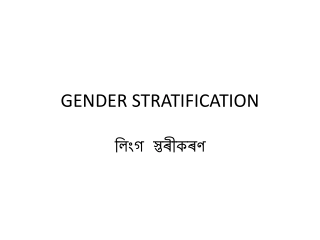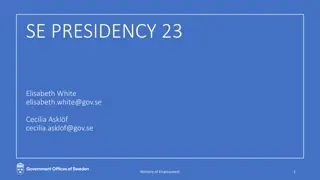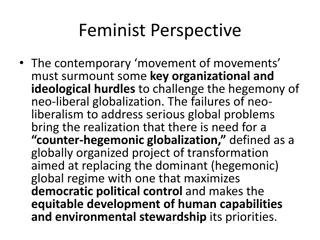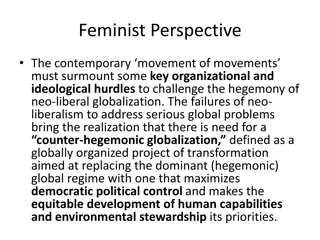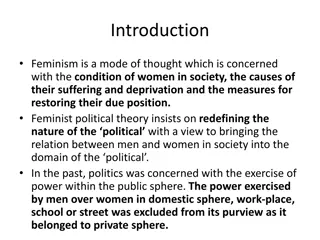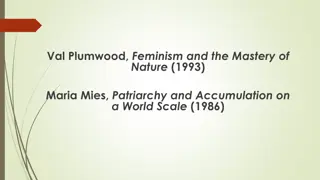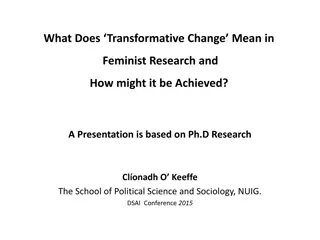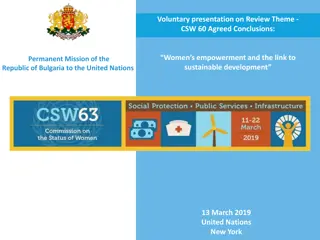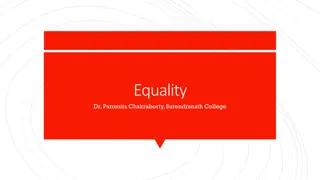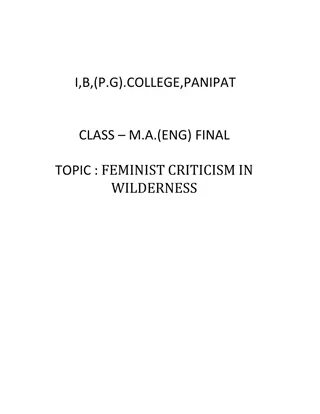Exploring Feminist Writing: Analyzing Gender Roles and Equality
Delve into feminist writing discussing the questioning of traditional gender norms, societal constructs, and the fight for gender equality. Analyze prominent works like "The Room of One's Own" by Virginia Woolf and "The Second Sex" by Simone de Beauvoir. Explore the challenges faced by women in a male-dominated society and the evolution of feminist thought over time.
Download Presentation

Please find below an Image/Link to download the presentation.
The content on the website is provided AS IS for your information and personal use only. It may not be sold, licensed, or shared on other websites without obtaining consent from the author. Download presentation by click this link. If you encounter any issues during the download, it is possible that the publisher has removed the file from their server.
E N D
Presentation Transcript
Dr.M.Kannadhasan Assistant Professor Dept.of English Thiruvalluvaruniversity
Today we are going to discuss about the title Introduction to Feminist Writing . I remember one event it was held in the year 2008 . The article was published in Hindu Newspaper written by Hema Subramaniam that was very much shocking to us She questions the relationship of marriage, she asked why women should accept the relationship of marriage?
She also said that loving husband is impossible and marriage and children s kills the romantic mood of the women. Like this, many articles were published in journals at the same Time. Here we must have one thing that we must understand and analyze the differences of feminist issues in eastern and western countries. The Oxford dictionary gives the meaning for the term feminism is The belief that men and women should have equal rights and opportunities
There are many books and articles have been published related to feminism. But we have the difficulty to analyze all the books and the articles at the same time. Here we have the four works and let us analyze the feministic issues and find the solutions for them. I) The Room of one s own Virginia wolf II) sexual politics Kate Millet III) The second sex Simon-de-Beauvoir IV) Towards feministic poetics- Elian Showalter
A woman is not born as women, they are created as women naturally and they do not come as women. But artificially men imposed femininity in them, they are considered as the secondary human being. The society do not show them as the Queen of the home but men want to show women as servant maid and cook in the name of the mother they are treated as the machine to produce the child.
For lustfulness of Husband She is treated as doll and call girl. Here marriage is considered as marriage. That is the illusionary thing to the women through this custom of society. women are bound with men in the name of marriage. Particularly some feminist protest for the terms we are using nowadays . They said, we do not use history( his story) and we must say her story and next mankind has to be changed as women kind generally the word Mr is used for men both married and unmarried. But there is no common word to identify women. We call unmarried women as Ms and married women Mrs. Here feminists insisted the male dominated society to use the common word as MS for all kinds of women
Virginia wolfs A Room of Ones Own Virginia wolfs A Room of Ones Own is a invited lecture on the topic women and fiction. She advances the thesis in which she says a women must have money and separate room of her own if she is to write fiction. Her essay is constructed as partly fictionalized narrative of the thinking to adopt in her thesis.
Women do not have access to his space to write men in the other hand always have space to create. they have opportunities that only a few privileged women have. She worries that we have lost a lot of talent and valuable stories over the centuries because of this. Wolf wonders how women writers of the past felt about their situation she is forced to draw her own conclusions that is all she can find are accounts written by men. Women are denied the space to talk among themselves however she notes that times are changing there is hope for the future. A Room of One s own is a safe space for wolf to discuss about lesbianism. She believes have a right to own their sexuality she is disappointed that the restraints are still placed upon female sexual expressions, she suggest the way in which her fellow writers can discuss Lesbianism without attracting criticism.
Woolf Teaches her audience the danger of complacency they cannot forget struggle of historical women because they will lose any progress they have made. Woolf's conclusion is literature is not just for some of us and only for men. it is for every ones interest to make sure we all have the chance to write and enjoy literature. we all have the right to see ourselves represented in literature.
Kate Millets Sexual Politics Kate millets sexual politics is a ground breaking feminist critique of literature. It opens with the brief exploration of fiction by Henry Miller Norman Miller and Jane Genet. Millet examines how power operates within the sexual relationships and builds a argument that the sexes between the political issues revolved around by one group by another.
The 2ndchapter makes this argument more explicit offering an analysis of material rule in contemporary and historical society. Millet explores how tradition climbs of made domains as natural. Before analyzing traditional sex traditional sex roles and patriarchal authority . Millet next examines the first phrase of the sexual revolution between 1830-1930 and through his period is known for its strictness and repression.
A great deal of nevertheless took place in politics of sex . The women movement made significant progress in opening up education for women and securing , suffering and as well as challenging traditional understanding of sex. The book closes with four chapters discussing in the greater details of works of D.H Lawrence novels explores Lawrence s hero s manipulated women in sexual liberations as the means of reestablishing the traditional sex and roles .
There is also an analyze of Lawrence dissatisfaction with women and his focus on male relationship with and his consideration on love and sexuality in trials of power . The chapter of mailer explores how his work pre occupies over sexualized male violence with the Notion that masculinity must be demonstrated at all times. The final chapter focuses on the works of Genet examining how he uses the homosexual sub- cultural of his early novels to reflect and satirized .Hetero sexual power relation which portray marginalized groups of various types challenging their oppressions.
Simon de Beauvoir The Second Sex Revolutionary and incendiary, The Second Sex is one of the earliest attempts to confront human history from a feminist perspective Today, many regard this massive and meticulously researched masterwork as not only as pillar of feminist thought but of twentieth-century philosophy in general. De Beauvoir s primary thesis is that men fundamentally oppress women by characterizing them, on every level, as the Other, defined exclusively in opposition to men.
Man occupies the role of the self, or subject; woman is the object, the other. He is essential, absolute, and transcendent. She is inessential, incomplete, and mutilated. He extends out into the world to impose his will on it, whereas woman is doomed to immanence, or inwardness. He creates, acts, invents; she waits for him to save her. The Second Sex chronicles De Beauvoir s effort to locate the source of these profoundly imbalanced gender roles.
In Book I, entitled Facts and Myths, she asks how female humans come to occupy a subordinate position in society. To answer this question and to better understand her own identity de Beauvoir first turns to biology, psychoanalysis, and historical materialism. These disciplines reveal indisputable essential differences between men and women but provide no justification for woman s inferiority. They all take woman s inferior destiny for granted.
Having brought the woman to adulthood, de Beauvoir analyzes the various situations, or roles, the adult woman inhabits. The bourgeois woman performs three major functions: wife, mother, and entertainer. No matter how illustrious the woman s household may be, these roles inevitably lead to immanence, incompleteness, and profound frustration. Even those who accept a less conventional place in society as a prostitute or courtesan, for example must submit to imperatives defined by the male.
De Beauvoir also reflects on the trauma of old age. When a woman loses her reproductive capacity, she loses her primary purpose and therefore her identity. In the final chapter of this section, Woman s Situation and Character, de Beauvoir reiterates the controversial claim that woman s situation is not a result of her character. Rather, her character is a result of her situation. Her mediocrity, complacency, lack of accomplishment, laziness, passivity all these qualities are the consequences of her subordination, not the cause.
Elaine Showalter: Towards A Feminist Poetics About the author: Elaine Showalter (born January 21, 1941) is an American literary critic, feminist, and writer on cultural and social issues. She is one of the founders of feminist literary criticism in United States academia, developing the concept and practice of gynocritics.
In Toward a Feminist Poetics Showalter divides feminist criticism into two sections: The Woman as Reader or Feminist Critique : the way in which a female reader changes our apprehension of a given text, awakening it to the significance of its sexual codes ; historically grounded inquiry which probes the ideological assumptions of literary phenomena ; subjects include the images and stereotypes of women in literature, the omissions of and misconceptions about women in criticism, and the fissures in male constructed literary history ; concerned with the exploitation and manipulation of the female audience, especially in popular culture and film, and with the analysis of woman as sign in semiotic systems ; political and polemical ; like the Old Testament looking for the errors of the past.
One of the problems of the feminist critique is that it is male orientated. If we study stereotypes of women, the sexism of male critics, and the limited roles women play in literary history, we are not learning what women have felt and experienced, but only what men thought women should be. [ ] The critique also has a tendency to naturalize women s victimization by making it the inevitable and obsessive topic of discussion.
The Woman as Writer or Gynocritics : Showalter coined the term 'gynocritics' to describe literary criticism based in a feminine perspective. Probably the best description Showalter gives of gyno critics is in Towards a Feminist Poetics: In contrast to [an] angry or loving fixation on male literature, the program of gynocritics is to construct a female framework for the analysis of women s literature, to develop new models based on the study of female experience, rather than to adapt male models and theories.
Gynocritics begins at the point when we free ourselves from the linear absolutes of male literary history, stop trying to fit women between the lines of the male tradition, and focus instead on the newly visible world of female culture. This does not mean that the goal of gyno critics is to erase the differences between male and female writing; gyno critics is not on a pilgrimage to the promised land in which gender would lose its power, in which all texts would be sexless and equal, like angels .
Rather gynocritics aims to understand the specificity of women s writing not as a product of sexism but as a fundamental aspect of female reality. Its prime concern is to see woman as producer of textual meaning, with the history themes, genres, and structures of literature by women . Its subjects include the psychodynamics of female creativity. It studies linguistics and the problem of a female language in literary text. It reviews the trajectory of the individual or collective female literary career. It proposes to construct a female framework for the analysis of women s literature, to develop new models based on women s experience .
Its study focuses on the newly visible world of female culture ; hypotheses of a female sub culture ; the occupations, interactions, and consciousness of women . It projects how feminine values penetrate and undermine the masculine systems that contain them . And at its extreme, it is engaged in the myth of the Amazons, and the fantasies of a separate female society . Showalter acknowledges the difficulty of defining the unique difference of women s writing which she says is a slippery and demanding task in Feminist Criticism in the Wilderness .
She says that gynocritics may never succeed in understanding the special differences of women s writing, or realize a distinct female literary tradition. But, with grounding in theory and historical research, Showalter sees gynocriticism as a way to learn something solid, enduring, and real about the relation of women to literary culture . Showalter then provides an exemplary feminist critique of Thomas Hardy s The Mayor of Caster bridge to demonstrate that one of the problems of the feminist critique is that it is male- oriented, meaning that, in some sense, every feminist critique, even when criticizing patriarchy, is focused toward the male. As an alternative, Showalter presents gynocritics as a way to construct a female framework for the analysis of women s literature, to develop new models based on the study of female experience, rather that to adapt to male models and theories.
To begin to trace out this radically female-centered theory, Showalter notes excerpts from feminist historians and sociologists. She then moves on to an engaging discussion of the experiences of Elizabeth Barrett Browning and other female authors to show the need for completeness in discussing women authors work way in which it is necessary to leave oneself room to deal with other things besides [women writers'] work, so much has that work been influenced by conditions that have nothing whatever to do with art.
Three Phases: From these experiences, Showalter then begins a rough sketch of some of the elements that have characterized women s writing: awakening, suffering, unhappiness, and matrophobia, among others. She concludes with her classification of women s writing into three phases that establish[es] the continuity of the female tradition from decade to decade, rather than from Great Woman to Great Woman. Thus, Showalter traces the history of women's literature, suggesting that it can be divided into three phases:
The Feminine phase (18401880): Showalter sees the first phases taking place from roughly 1840 to 1880; she calls this the Feminine phase and declares that it is characterized by women [writing] in an effort to equal the intellectual achievements of the male culture The distinguishing sign of this period is the male pseudonym [which] exerts an irregular pressure on the narrative, affecting tone, diction, structure, and characterization.
The Feminist phase (18801920): The second, Feminist phase follows from 1880 to 1920, wherein women are historically enabled to reject the accommodating postures of femininity and to use literature to dramatize the ordeals of wronged womanhood. This phase is characterized by Amazon Utopias, visions of perfect, female-led societies of the future. This phase was characterized by women s writing that protested against male standards and values, and advocated women s rights and values, including a demand for autonomy.
The Female phase (1920 - Present ) is one of self-discovery. Showalter says, women reject both imitation and protest two forms of dependency and turn instead to female experience as the source of an autonomous art, extending the feminist analysis of culture to the forms and techniques of literature . Significantly, Showalter does not offer a characteristic sign or figure for the Female phase, suggesting a welcome diversity of experience that is too broad to be encompassed in a single image. Rejecting both imitation and protest, Showalter advocates approaching feminist criticism from a cultural perspective in the current Female phase, rather than from perspectives that traditionally come from an andocentric perspective like psychoanalytic and biological theories, for example.
Feminists in the past have worked within these traditions by revising and criticizing female representations, or lack thereof, in the male traditions (that is, in the Feminine and Feminist phases). In her essay Feminist Criticism in the Wilderness (1981), Showalter says, "A cultural theory acknowledges that there are important differences between women as writers: class, race nationality, and history are literary determinants as significant as gender. Nonetheless, women s culture forms a collective experience within the cultural whole, an experience that binds women writers to each other over time and space".
On the whole, we may conclude that her views on feminist poetics are intelligent, largely devoid of rhetorical extremities, and confidently provocative. Showalter speaks with calmly convincing authority, as one who firmly believes in the verity of what she s saying. She is both earnest, in that she sees change needing to occur immediately, and patient, in that she expects that, given time enough, the wisdom and truth of her cause will prevail.
Feminism in Indian context Traditionally, right from the ancient days, India was a male- dominated culture. Indian women were covered with many thick, slack layers of prejudice, convention, ignorance and reticence in literature as well as in life. They were inanimate objects, who followed five paces behind their men, they had to be gentle, patient, gracious, and for generations together. The Indian woman today is no longer a Damayanti, she is a Draupadi or a damius or a Nora or a candid Joan of Arc.
Social reformers, Raja Ram Mohan Ray, Pandit Iswar Chandra Vidyasagarand political revolutionaries like Mahatma Gandhi and Pandit Nehru lent her a new dimension, gave her a new direction. The term feminism in India refers to a set of movements intending to define, establish, and defend equal political, economic and social rights and equal opportunities for Indian women.
Like their feminist counterparts in the world, feminists in India seek gender equality. This can be the right to work for equal wages, to have access to health and education as well as political rights. It is worth mentioning that feminists in India have also fought against cultural issues within the patriarchal society of India, such as inheritance laws and the practice of widow immolation known as Sati.
The history of feminism in India can be divided into three phases: the first phase, beginning in the mid- nineteenth century, initiated when male European colonists began to speak out against the social evils of Sati. The second phase, from 1915 to Indian independence, when Gandhi incorporated women's movements into the Quit India movement, and independent women's organizations began to emerge.
Finally, the third phase, post-independence, which has focused on fair treatment of women in the work force and right to political parity. The coming of M. K. Gandhi changed the total scenario. He gave a new direction and dimension to the Feminist movement in India. He freed women from passivity, servility, and domesticity. Feminism as a new way of life, as a new viewpoint came into existence in India with the partiality of feminine and trying to redefine woman s role and situation in the society.
Women's role in Pre-colonial social structures reveals that feminism was theorized differently in India than in the West. In India, women s issues first began to be addressed when the state commissioned a report on the status of women to a group of feminist researchers and activists. The report recognized the fact that in India, women were oppressed under a system of structural hierarchies and injustices. During this period, Indian feminists were influenced by the Western debates being conducted about violence against women.
Despite the progress made by Indian feminist movements, women living in modern India still face many issues of discrimination. India's patriarchal culture has made the process of gaining land- ownership rights and access to education challenging. Unlike the Western feminist movement, India s movement was initiated by men, and later joined by women. The efforts of these men included abolishing sati, which was a widow's death by burning on her husband's funeral pyre.
The custom of child marriage, abolishing the disfiguring of widows, banning the marriage of upper caste Hindu widows, promoting women s education, obtaining legal rights for women to own property, and requiring the law to acknowledge women s status by granting them basic rights in matters such as adoption. It was believed that men and women were partners, sharing equal duties in social life and equal rights in political field. Though the Municipal vote for Indian women was acquired right in 1855, but it had not been properly utilized by them for lack of education, lack of opportunity for self-development, lack of interest in social problems. Women had enjoyed equal rights with men in the Vedic days. They had the opportunity of receiving the highest education.
Hence, Gandhi acclaimed the concept of Ardhangini, enshrined in Indian culture, and accepted the fact that men and women are complement to each other, and one is never a whole without the other. He proclaimed the scriptures, which conceived Prakriti and Purusha as one, man and woman as one in the concept of Ardhanariswara.
Feminism and Nationalism Sarojini Naidu s presidential address to the All India Women s Conference (AIWC) in Bombay in 1930 arrests two central themes. They are, firstly the tension with the western origins of feminism and secondly, the construction of a nationalism that erases internal differences, perceived as potential threats to nationalism. Naidu addressed the women s conference in the following words:
We are not weak, timid, meek women, we hold the courageous Savitri as our ideal, we join how Sita defied those who entertained those suspicious of her ability to keep her chastity. We possess the spirit of creative energy to legislate for the moral of the world. I think this conference is writing the history of women of the world. I am not a feminist. To be a feminist is to acknowledge that one s life has been repressed. The demand for granting preferential treatment to woman is an admission on her part of her inferiority and there has been no need for such a thing in India as the women have always been on the side of men in council and in the fields of battle . We must have no mutual conflicts in our homes or abroad. We must transcend differences. We must rise about above nationalism, above religion, and above sex.
Prime Minister Indira Gandhi addressing the All India Womens Conference in 1980 said: . . . I have often said, that, I am not a feminist, yet, in my concern for the unprivileged, how can I ignore women who, since the beginning of history, have been dominated over and discriminated against in social custom and in laws . . ? In the west, women s so- called freedom is often equated with imitation of man. Frankly, I feel that is merely an exchange of one kind of bondage for another. To be liberated, a woman must feel free to be herself, not in rivalry to man, but in the context of her own capacity and her personality. We need women to be more interested, more alive and more active, not because they are women,
but because they do comprise half the human race. Whether they like it, or not, they cannot escape their responsibility nor should they be denied its benefits. Indian women are traditionally conservatives but they also have the genius of synthesis to adapt and absorb. That is what gives them resilience to face suffering and to meet upheavals with a degree of calm, to change constantly and yet remain changeless which is the quality of India herself.
This speech dominating nationalist frame resurfaces the conflation of the Indian women with Indian nation and culture and its very special identity.
Literary feminism in India Indian literature of the twentieth century is a memorable record of the triumph and tragedy of Indian people involved in the most significant engagement in their history, the struggle for independence and the challenges that followed the achievement of that goal. Feminism throws a challenge on the age-long tradition of gender differentiation. It attempts to explore and find a new social order, to find pertinent resolves to the real life problems in the light of traditionally-gendered role-playing. Woman has always been projected as a secondary and inferior human being.
Feminism is perhaps the most powerful movement that swept the literary world in the recent decades. It has been articulated differently in different parts of the world by various writers depending upon their class, background and level of consciousness. As a critical tool, feminism aims at providing an altogether new awareness of women s role in the modern complex world.
Famous feminists in India such as Anita Desai and Shashi Deshpande, wrote significant novels in this field. Here we explain briefly Ms Deshpande s novel and her perspective. One of the important novels by Shashi Deshpande is The Dark Holds No Terrors In. This novel has been translated into the German and Russian languages. She very well portrays modern, educated and career- oriented middle class women, who are sensitive to the changing time and situations.


